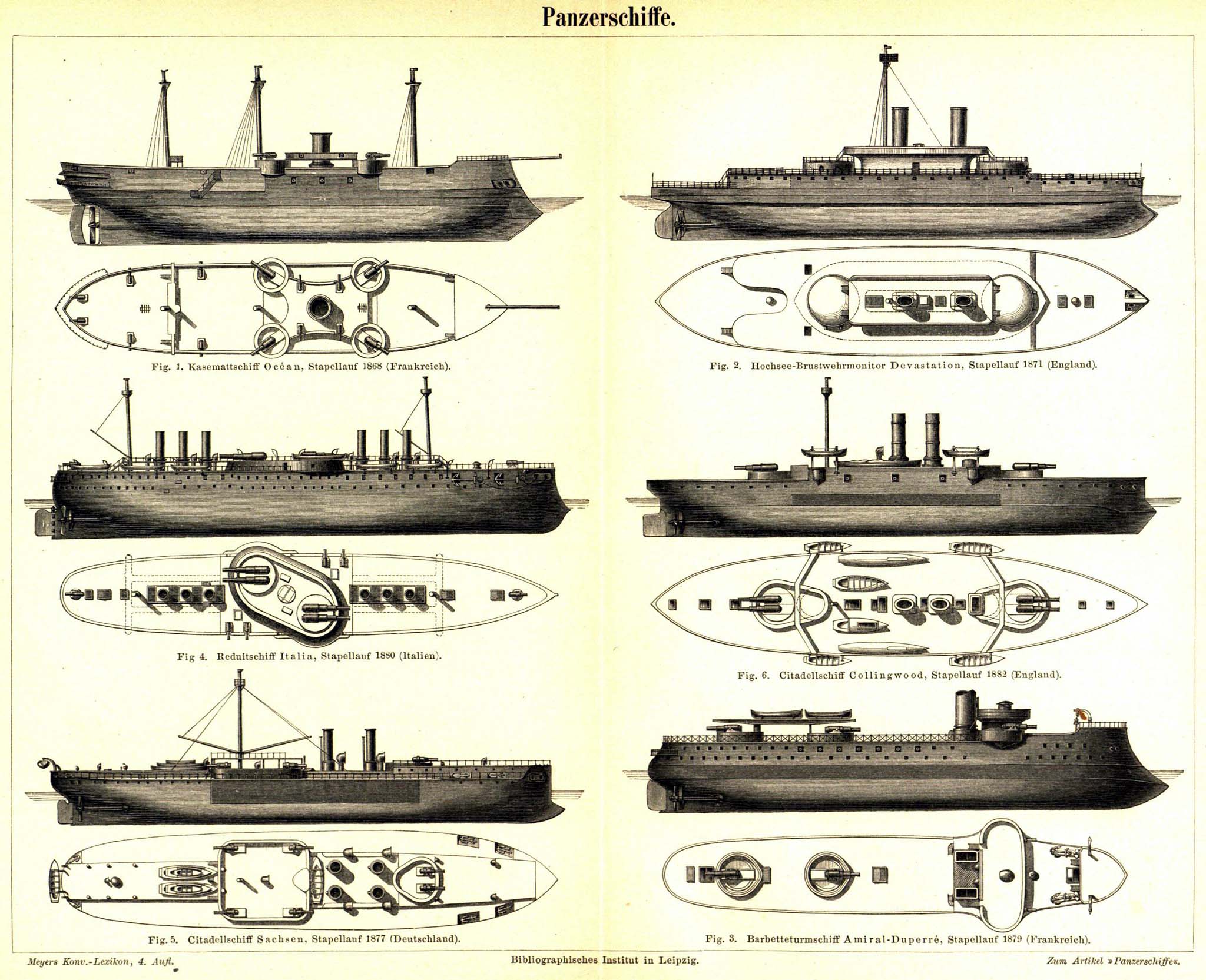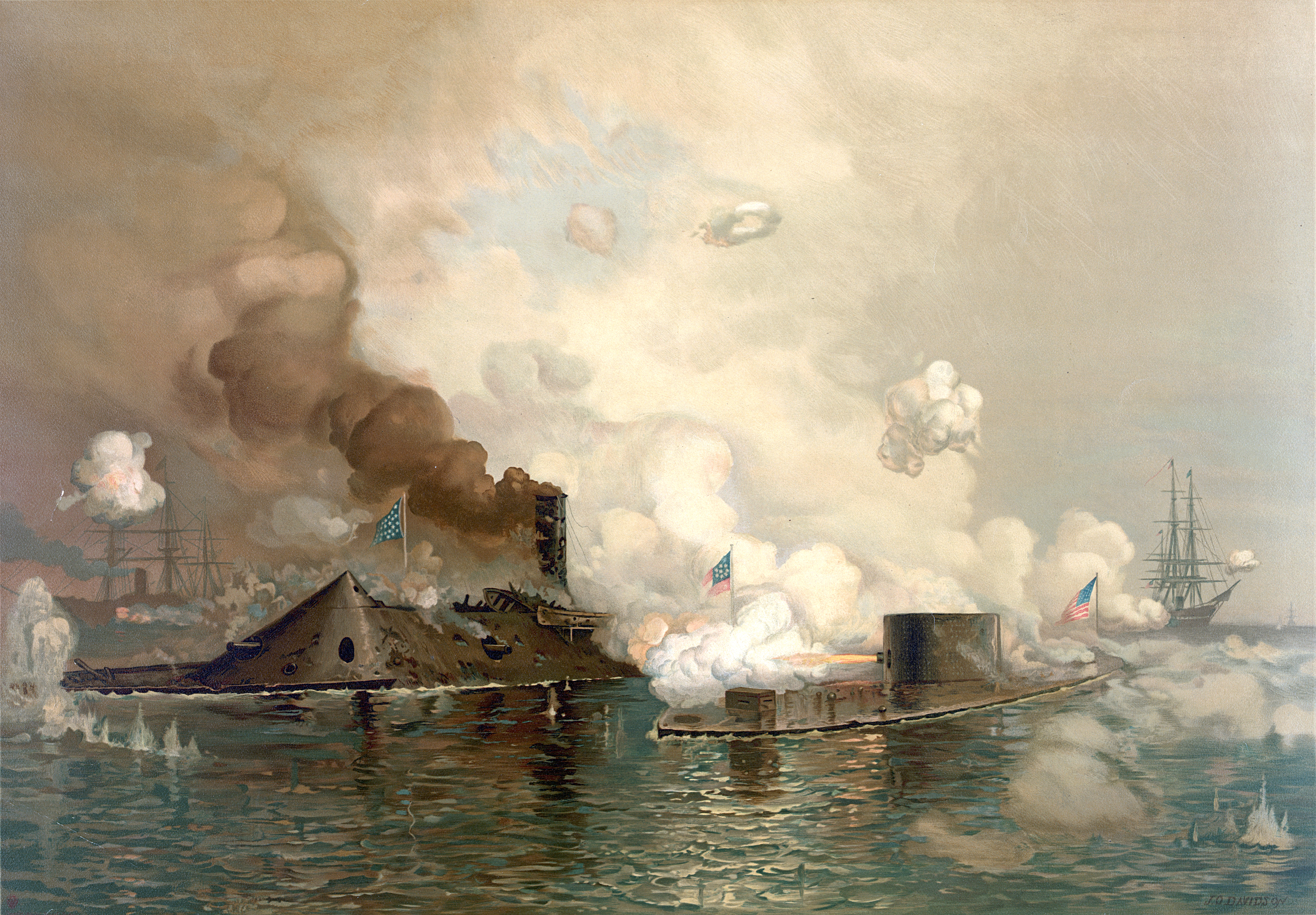|
Italia-class Ironclad
The ''Italia'' class was a class of two ironclad battleships built for the Italian ''Regia Marina'' (Royal Navy) in the 1870s and 1880s. The two ships— and —were designed by Benedetto Brin, who chose to discard traditional belt armor entirely, relying on a combination of very high speed and extensive internal subdivision to protect the ships. This, along with their armament of very large guns, has led some naval historians to refer to the ''Italia'' class as prototypical battlecruisers. Despite serving for over thirty years, the ships had uneventful careers. They spent their first two decades in service with the Active and Reserve Squadrons, where they were primarily occupied with training maneuvers. ''Lepanto'' was converted into a training ship in 1902 and ''Italia'' was significantly modernized in 1905–1908 before also becoming a training ship. They briefly saw action during the Italo-Turkish War, where they provided gunfire support to Italian troops defending Tripoli. ... [...More Info...] [...Related Items...] OR: [Wikipedia] [Google] [Baidu] |
Ironclad Warship
An ironclad is a steam engine, steam-propelled warship protected by Wrought iron, iron or steel iron armor, armor plates, constructed from 1859 to the early 1890s. The ironclad was developed as a result of the vulnerability of wooden warships to explosive or incendiary shell (projectile), shells. The first ironclad battleship, , was launched by the French Navy in November 1859 - narrowly pre-empting the British Royal Navy. They were first used in warfare in 1862 during the American Civil War, when ironclads operated against wooden ships and, in a historic confrontation, against each other at the Battle of Hampton Roads in Virginia. Their performance demonstrated that the ironclad had replaced the unarmored ship of the line as the most powerful warship afloat. City-class ironclad, Ironclad gunboats became very successful in the American Civil War. Ironclads were designed for several uses, including as high seas battleships, long-range cruisers, and Littoral (military), coast ... [...More Info...] [...Related Items...] OR: [Wikipedia] [Google] [Baidu] |
Battlecruiser
The battlecruiser (also written as battle cruiser or battle-cruiser) was a type of capital ship of the first half of the 20th century. These were similar in displacement, armament and cost to battleships, but differed in form and balance of attributes. Battlecruisers typically had thinner armour (to a varying degree) and a somewhat lighter main gun battery than contemporary battleships, installed on a longer hull with much higher engine power in order to attain greater speeds. The first battlecruisers were designed in the United Kingdom, as a development of the armoured cruiser, at the same time as the dreadnought succeeded the pre-dreadnought battleship. The goal of the design was to outrun any ship with similar armament, and chase down any ship with lesser armament; they were intended to hunt down slower, older armoured cruisers and destroy them with heavy gunfire while avoiding combat with the more powerful but slower battleships. However, as more and more battlecruisers we ... [...More Info...] [...Related Items...] OR: [Wikipedia] [Google] [Baidu] |
Armor Belt
Belt armor is a layer of heavy metal armor plated onto or within the outer hulls of warships, typically on battleships, battlecruisers and cruisers, and aircraft carriers. The belt armor is designed to prevent projectiles from penetrating to the heart of a warship. When struck by an artillery shell or underwater torpedo, the belt armor either absorbs the impact and explosion with its sheer thickness and strength, or else uses sloping to redirect the projectile and its blast downwards. Typically, the main armor belt covers the warship from its main deck down to some distance below the waterline. If, instead of forming the outer hull, the armor belt is built inside the hull, it is installed at a sloped angle for improved protection, as described above. The torpedo bulkhead Frequently, the main belt's armor plates were supplemented with a torpedo bulkhead spaced several meters behind the main belt, designed to maintain the ship's watertight integrity even if the main b ... [...More Info...] [...Related Items...] OR: [Wikipedia] [Google] [Baidu] |
Armor-piercing Shell
Armour-piercing ammunition (AP) is a type of projectile designed to penetrate either body armour or vehicle armour. From the 1860s to 1950s, a major application of armour-piercing projectiles was to defeat the thick armour carried on many warships and cause damage to their lightly-armoured interiors. From the 1920s onwards, armour-piercing weapons were required for anti-tank warfare. AP rounds smaller than 20 mm are intended for lightly-armoured targets such as body armour, bulletproof glass, and lightly-armoured vehicles. As tank armour improved during World War II, anti-vehicle rounds began to use a smaller but dense penetrating body within a larger shell, firing at very high muzzle velocity. Modern penetrators are long rods of dense material like tungsten or depleted uranium (DU) that further improve the terminal ballistics. History The late 1850s saw the development of the ironclad warship, which carried wrought iron armour of considerable thickness. This ... [...More Info...] [...Related Items...] OR: [Wikipedia] [Google] [Baidu] |
Simone Antonio Saint-Bon
Simone Antonio Pacoret de Saint-Bon (March 20, 1828 – November 26, 1892) was an admiral of the Italian ''Regia Marina'' (Royal Navy). Saint-Bon was born at Chambéry, now in France, then part of the Kingdom of Sardinia. Leaving the Naval Academy in 1847, he attained the rank of commander in 1860, and that of vice-admiral in 1867. He took part in the Crimean war, distinguished himself in 1860 at the siege of Ancona, and was decorated for valor at the Siege of Gaeta. At the battle of Battle of Lissa (1866), his vessel, the , forced the entrance of the port of San Giorgio and silenced the Austrian batteries, for which exploit he received a gold medal. In 1873 he was elected deputy, and appointed by Marco Minghetti to be minister of marine, in which position he revolutionized the Italian navy. Insisting upon the need for large battleships with high powers of attack and defense, and capable of fighting as single units, he introduced the colossal types of which and were the earlie ... [...More Info...] [...Related Items...] OR: [Wikipedia] [Google] [Baidu] |
Austro-Hungarian Navy
The Austro-Hungarian Navy or Imperial and Royal War Navy (german: kaiserliche und königliche Kriegsmarine, in short ''k.u.k. Kriegsmarine'', hu, Császári és Királyi Haditengerészet) was the naval force of Austria-Hungary. Ships of the Austro-Hungarian Navy were designated ''SMS'', for '' Seiner Majestät Schiff'' (His Majesty's Ship). The k.u.k. Kriegsmarine came into being after the formation of Austria-Hungary in 1867, and ceased to exist in 1918 upon the Empire's defeat and subsequent collapse at the end of World War I. Prior to 1867, the Imperial Austrian Navy or simply the Austrian Navy, saw action in the French Revolutionary Wars, the Napoleonic Wars, the Austrian expedition against Morocco (1829), the Second Egyptian–Ottoman War, the First and Second Wars of Italian Independence, the Second Schleswig War, and the Third War of Italian Independence. Following Austria's defeat by Prussia and Italy during the Seven Weeks' War, the Austrian Empire reformed it ... [...More Info...] [...Related Items...] OR: [Wikipedia] [Google] [Baidu] |
Battle Of Lissa (1866)
The Battle of Lissa (or Battle of Vis) ( hr, Bitka kod Visa) took place on 20 July 1866 in the Adriatic Sea near the Dalmatian island of Vis () and was a significant victory for an Austrian Empire force over a numerically superior Italian force. It was the first major sea battle between ironclads and one of the last to involve deliberate ramming. The Italian navy fired roughly 1450 shots during the engagement, but failed to sink any Austrian ship while losing two ironclads. One of the main reasons for this poor performance was internal rivalry between the Italian fleet commanders: for example, Italian Vice Admiral Albini, with his ships, did not engage the enemy during the battle. The engagement was made up of several small battles: the main battle was between seven Austrian and twelve Italian ironclads and showed the ability of Austrian commander Tegetthoff to divide his more numerous opponents and then destroy the isolated ironclads. Background The battle occurred as par ... [...More Info...] [...Related Items...] OR: [Wikipedia] [Google] [Baidu] |
NH 88711 Enrico Dandolo
NH or Nh may refer to Businesses and organizations * All Nippon Airways (IATA code NH), formerly Nippon Helicopter, Japan's largest airline * National Agricultural Cooperative Federation, a South Korean cooperative federation also known by its Korean initials NH (''Nonghyup'') * New York, New Haven and Hartford Railroad * NH (media company), formerly ', a Dutch broadcasting company * NH Hotel Group, formerly ', a Spanish-based hotel chain * NH Media ("''Nam Hee''"), a South Korean entertainment agency * Nordsjælland Håndbold, a Danish handball team Places * New Hampshire, US (postal abbreviation NH) * New Haven, a city in Connecticut, United States * Noroton Heights, Connecticut, a town in Connecticut, United States * North Holland, a province in the Netherlands * Nowa Huta, a district of Kraków, Poland In science and technology * Nh (digraph), an orthographic concept * National Hose Thread, a threaded connection standard used on hose couplings * Nickel hydride, a type of rec ... [...More Info...] [...Related Items...] OR: [Wikipedia] [Google] [Baidu] |
Ship Breaking
Ship-breaking (also known as ship recycling, ship demolition, ship dismantling, or ship cracking) is a type of ship disposal involving the breaking up of ships for either a source of parts Part, parts or PART may refer to: People *Armi Pärt (born 1991), Estonian handballer * Arvo Pärt (born 1935), Estonian classical composer *Brian Part (born 1962), American child actor *Dealtry Charles Part (1882–1961), sheriff (1926–1927) a ..., which can be sold for re-use, or for the extraction of raw materials, chiefly scrap. Modern ships have a lifespan of 25 to 30 years before corrosion, Fatigue (material), metal fatigue and a lack of parts render them uneconomical to operate. Ship-breaking allows the materials from the ship, especially steel, to be recycling, recycled and made into new products. This lowers the demand for mined iron ore and reduces energy use in the steelmaking process. Fixtures and other equipment on board the vessels can also be reused. While ship-breaking i ... [...More Info...] [...Related Items...] OR: [Wikipedia] [Google] [Baidu] |
World War I
World War I (28 July 1914 11 November 1918), often abbreviated as WWI, was List of wars and anthropogenic disasters by death toll, one of the deadliest global conflicts in history. Belligerents included much of Europe, the Russian Empire, the United States, and the Ottoman Empire, with fighting occurring throughout Europe, the Middle East, Africa, the Pacific Ocean, Pacific, and parts of Asia. An estimated 9 million soldiers were killed in combat, plus another 23 million wounded, while 5 million civilians died as a result of military action, hunger, and disease. Millions more died in Genocides in history (World War I through World War II), genocides within the Ottoman Empire and in the Spanish flu, 1918 influenza pandemic, which was exacerbated by the movement of combatants during the war. Prior to 1914, the European great powers were divided between the Triple Entente (comprising French Third Republic, France, Russia, and British Empire, Britain) and the Triple A ... [...More Info...] [...Related Items...] OR: [Wikipedia] [Google] [Baidu] |
Guard Ship
A guard ship is a warship assigned as a stationary guard in a port or harbour, as opposed to a coastal patrol boat, which serves its protective role at sea. Royal Navy In the Royal Navy of the eighteenth century, peacetime guard ships were usually third-rate or fourth-rate ships of the line. The larger ships in the fleet would be laid up "in ordinary" with skeleton crews, the spars, sails and rigging removed and the decks covered by canvas – the historic equivalent of a reserve fleet. By contrast the guard ships would carry sails and rigging aboard, be defouled below the waterline to increase their speed under sail, and be manned by at least one quarter of their normal crew. A port or major waterway may be assigned a single guardship which would also serve as the naval headquarters for the area. Multiple guardships were required at larger ports and Royal Dockyards, with the largest single vessel routinely serving as the Port Admiral's flagship. If war was declared, or an e ... [...More Info...] [...Related Items...] OR: [Wikipedia] [Google] [Baidu] |
Tripoli, Libya
Tripoli (; ar, طرابلس الغرب, translit= Ṭarābulus al-Gharb , translation=Western Tripoli) is the capital and largest city of Libya, with a population of about 1.1 million people in 2019. It is located in the northwest of Libya on the edge of the desert, on a point of rocky land projecting into the Mediterranean Sea and forming a bay. It includes the port of Tripoli and the country's largest commercial and manufacturing center. It is also the site of the University of Tripoli. The vast barracks, which includes the former family estate of Muammar Gaddafi, is also located in the city. Colonel Gaddafi largely ruled the country from his residence in this barracks. Tripoli was founded in the 7th century BC by the Phoenicians, who gave it the Libyco-Berber name ( xpu, 𐤅𐤉𐤏𐤕, ) before passing into the hands of the Greek rulers of Cyrenaica as Oea ( grc-gre, Ὀία, ). Due to the city's long history, there are many sites of archeological s ... [...More Info...] [...Related Items...] OR: [Wikipedia] [Google] [Baidu] |


_-_March_17%2C_1924.jpg)


.jpg)

